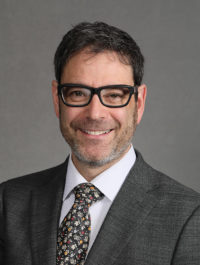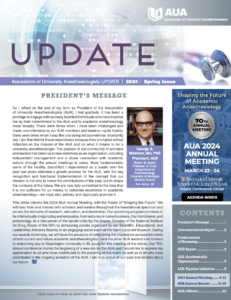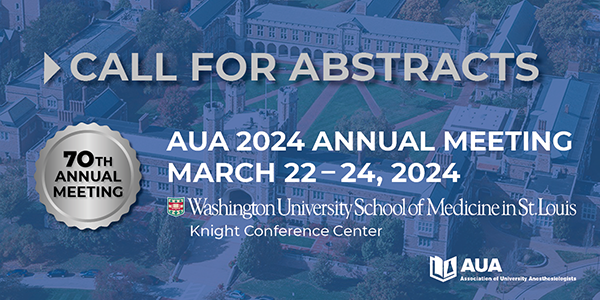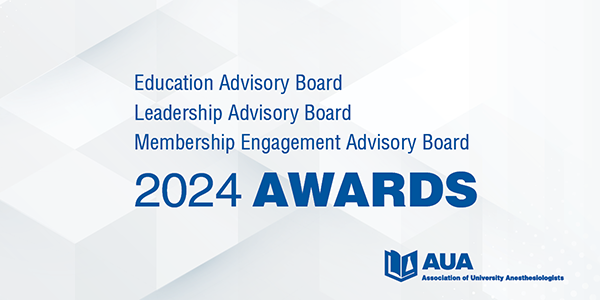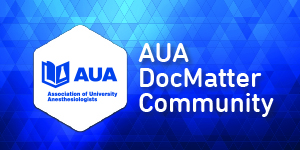Revisiting the Vision and Mission of the AUA
The AUA Council recently held a retreat at which it discussed its Mission and reformulated its strategic plan. Dr. Alex Evers kindly facilitated the discussion, and helped to ensure that it was focused, action oriented, and high level. This is the current Mission statement of the AUA:
The Mission of the AUA is the advancement of the Art & Science of Anesthesiology by:
- the encouragement of its Members to pursue original investigations in the clinic and in the laboratory
- the development of the method of teaching (anesthesia)
- free and informal interchange of ideas
It was largely felt by Council Members at the retreat that the AUA’s current Mission is vague, and, as such, the organization does little to deliberately advance these stated aims. The main utility of the AUA is currently to organize a premier scientific meeting, and also to facilitate networking among academic anesthesiologists. Membership is viewed primarily as merely honorific, with Members not generally seeing that there is a service obligation.
There was a strong view that there should be a shift in emphasis in the AUA’s Vision and Mission. The consensus was that the AUA should remain honorific, but that those becoming Members should expect to participate actively in activities designed to further the Mission of the AUA. The following are suggested amended Vision and Mission statements for the AUA.
The Association of Anesthesiology has as its Vision the furtherance of anesthesiology as a dynamic academic medical specialty, with a vibrant community of successful scientific, educational and medical leaders within the academic sector.
The Mission of the AUA is to bolster academic anesthesiology through
- deliberate mentorship of academic anesthesiologists, under the rubric of faculty development;
- programmatic and ongoing career development of anesthesiology researchers, educators, and academic leaders throughout their careers;
- the organization of an outstanding annual academic meeting;
- targeted provision of networking opportunities to academic anesthesiologists.
In order to achieve these strategic Mission-based goals, the AUA must develop a tactical program with measurable outcomes. To this end, leadership development of academic anesthesiologists, and their engagement to achieve appreciable results to advance the Mission of the AUA was identified as a high yield investment. There are two components to the leadership Mission: (i) leadership development for academic anesthesiologists who are oriented towards scholarship, and (ii) leadership training for those Members of the academic community who may not aspire to substantial personal scholarly accomplishment, but who intend to advance scholarship in anesthesiology through their leadership. AUA Council Members recognized that this proposed change in Mission constitutes a major shift in emphasis for the AUA, and will need to be presented to the organization as a whole for endorsement.
The following action items were suggested as next steps:
- The AUA Council will ensure that the broad Membership of the AUA is aware of the planned change in direction. This article is the first step to accomplishing this aim.
- The Members of the AUA will have the ability to endorse, modify or reject the shift in the AUA’s Mission. In order to address this, the modified Vision and Mission statements will be presented at next year’s AUA business meeting. Following discussion and possible amendments, the Membership will have the opportunity to vote on the proposed changes.
- We will consider forming a Leadership Development Taskforce within the AUA, with the specific mandate to conceptualize and beta test academic leadership development programs.
- A meeting will be held, including the leadership of the AUA and other stakeholder organizations, to discuss how the various organizations can complement their various Missions, and how best to work together strategically.
- We must redefine and refine the criteria for AUA Membership with more specific criteria, and now including three broad (and not mutually exclusive) categories: (i) researchers, (ii) educators and (iii) leaders at major academic anesthesiology departments, who have achieved outcomes that are in alignment with the Mission of the AUA.
- In relation to leadership, we need to clarify that there are two key changes that are proposed, one of which is Mission related and one of which is Membership related.
- Regarding Membership, key leaders of major academic departments who have made modest personal contributions to scholarship (in research and education), but who have demonstrably promoted scholarship in anesthesiology in their capacity as leaders, might qualify for AUA Membership. As with all candidates for Membership, they would need to be nominated by an Active AUA Member, and their candidacy would be assessed by the AUA Council and the broad AUA Membership.
- Regarding Mission, the AUA will create leadership development programs at our meeting and potentially elsewhere. Such programs will be targeted at aspiring academic leaders who do not need to meet AUA Membership criteria. Hopefully many of them will become influential leaders in academic anesthesiology and will also become actively contributing AUA Members.
- The EAB and SAB will consider how the meeting furthers the modified Mission of the AUA. If the change in Mission is adopted, there will potentially need to be a complete reappraisal of the annual meeting.
- The AUA will solicit input from academic anesthesiology chairs regarding these proposed changes, and for practical advice on how to enhance leadership in the field in order to have outcomes that are in alignment with the Mission of the AUA.
- The AUA must continue to provide guidance and mentorship to promising organizations representing future anesthesiology leaders, such as the Early Stage Anesthesiology Scholars. It was suggested that eSAS should have representation on the AUA Council, the SAB, the EAB, and possibly the Leadership Development Taskforce. These representatives must also be Associate Members of the AUA.
- The AUA will continue to work with other organization on project-based initiatives, such as the Initiative for Multidisciplinary Pragmatic Anesthesiology Clinical Trials (IMPACT).
- The AUA Council will create a working group with representation from the AUA Council, eSAS, EAB, SAB, and also the proposed Leadership Development Taskforce to plan strategically for the 2020 meeting and beyond. As mentioned previously, the eSAS representative must also be an Associate AUA Member.
Michael Avidan, AUA President
Jeffrey Kirsch, AUA President-Elect
On Behalf of the AUA Council
